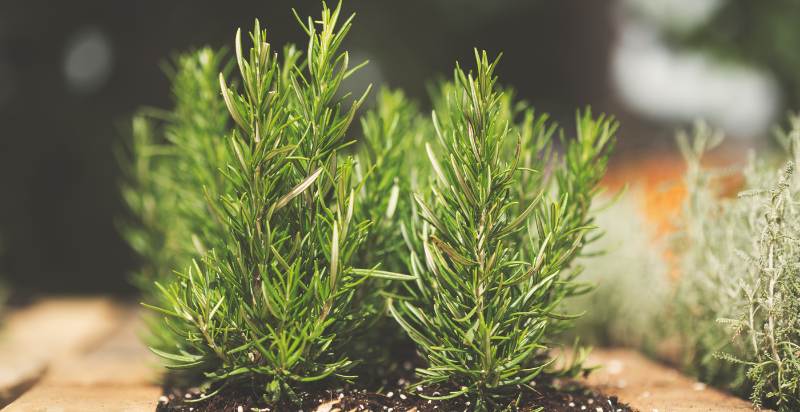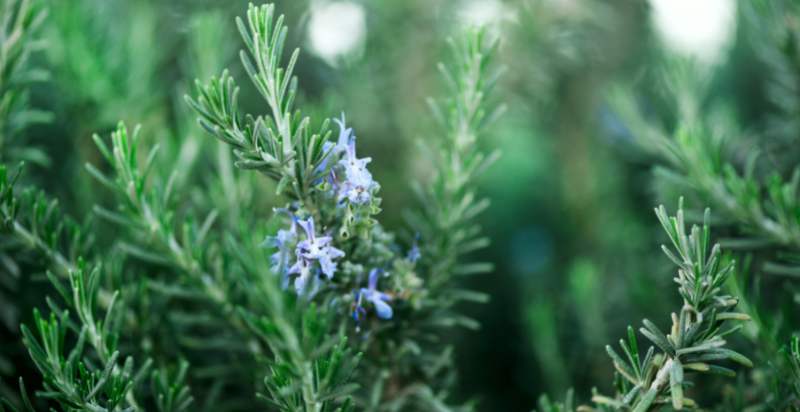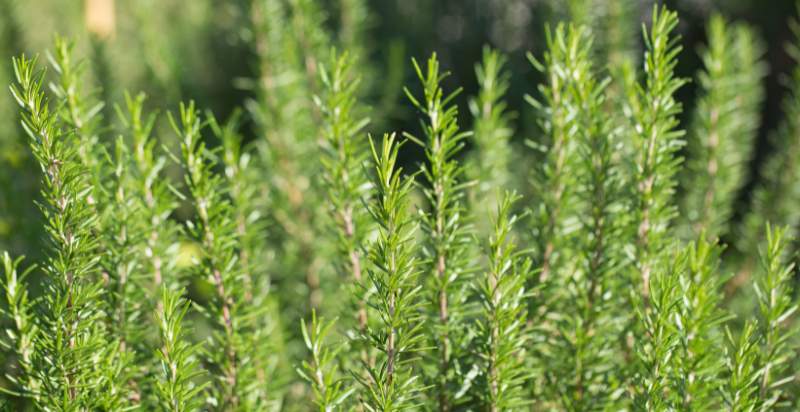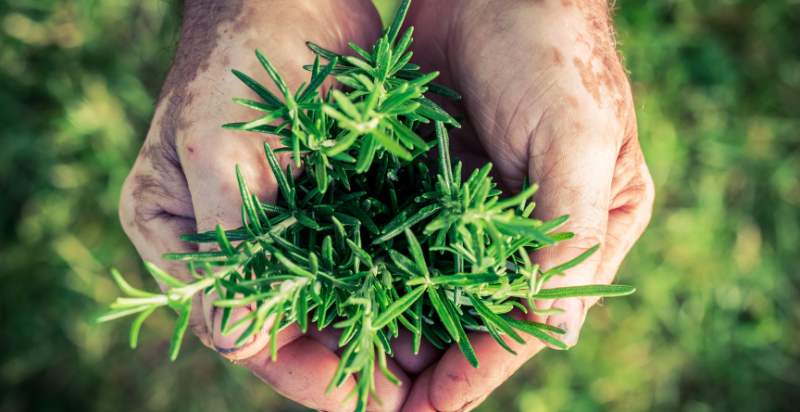Rosemary is an aromatic, perennial herb native to the Mediterranean region and widely used for culinary purposes. It has small, evergreen leaves with a slightly bitter flavor that can be used fresh or dried to enhance various dishes. Rosemary also has a long history of medicinal and therapeutic uses in aromatherapy and natural remedies. This article will discuss everything you wanted to know about rosemary.
What is Rosemary?
Rosemary is an aromatic herb with needle-like leaves and a woody, pine-like flavor. It is native to the Mediterranean region but can be grown in many other parts of the world. Rosemary grows best in a sunny location in well-drained soil with plenty of organic matter. The leaves are harvested fresh or dried for use as herbs.
Description of Rosemary Plants:
Rosemary plants typically reach heights of one to two feet and may grow as tall as four feet in ideal conditions. Its evergreen leaves are narrow and needle-like, ranging from 0.5 inches to 2 inches in length. The flowers vary in color from white to blue, pink, or purple, depending on the variety grown. When harvesting rosemary for culinary use, it is best to pick the leaves when they’re full of flavor before the plant flowers.
History Of Rosemary Plants:
Rosemary has a long and unique history. The ancient Greeks, Romans, and Egyptians all used the herb for medicinal purposes and to enhance food flavor. In the Middle Ages, rosemary symbolized love and fidelity in wedding ceremonies. It has been used to treat ailments such as headaches, indigestion, and depression. Today, rosemary is still widely used in cooking and natural healing practices.
Types Of Rosemary:
There are wide different varieties of rosemary that vary in size, shape, and color. The most popular variety is the common or “true” rosemary (Rosmarinus officinalis). Other types include Tuscan blue, Arp, Hill Hardy, St. John’s Wort, Prostratus, and Creeping rosemary.
Nutritional Value Of Rosemary Plants:
Rosemary is an excellent source of several nutrients like vitamins A and C, iron, calcium, and magnesium. It also contains high amounts of antioxidants that can help protect against oxidative stress and damage from free radicals.
These antioxidants also help reduce inflammation and may even prevent chronic diseases like cancer. Additionally, rosemary can be used as a natural preservative due to its antimicrobial properties.
Culinary Uses Of Rosemary:
Rosemary can be used in various culinary dishes just like marjoram, thyme, basil, and sage to add flavor and aroma. It makes an excellent addition to savory dishes like poultry, fish, roasted vegetables, soups, and stews. Rosemary is a popular seasoning for many Mediterranean dishes, such as focaccia bread and Italian pasta. The herb can be added to olive oil or butter to make flavorful sauces and dressings. Rosemary also pairs well with garlic and other herbs like sage and thyme.
Rosemary is also most commonly used for cooking, but it has many therapeutic uses in aromatherapy and herbal medicine. Just like Lemongrass its essential oil is also known for its stimulating, calming, and antiseptic properties and can be used to treat several physical ailments such as headaches, congestion, and even muscle aches.
Rosemary essential oil can also be massaged into the skin or added to a warm bath for stress relief and relaxation. Additionally, rosemary tea can be brewed from fresh or dried leaves to provide health benefits, including digestion support.
How To Plant Rosemary?
Rosemary is an incredibly versatile and fragrant herb used in various dishes or as a decorative addition to any garden. While some varieties are perennial, others must be planted each year, so it is important to know how to plant rosemary to ensure proper success.
Step 1: Choose the Right Soil
Before planting, it is important to ensure that the soil is of good quality. Rosemary prefers slightly alkaline soil with a pH between 6 and 8. The soil should be well-draining and free from weeds or debris.
Step 2: Prepare the Soil
Once the soil has been chosen, it must be prepared for planting by removing weeds or large stones from the area and breaking up hard clumps of dirt. Adding compost or peat moss can help create a more nutrient-rich environment for the rosemary plant.
Step 3: Planting Rosemary
Rosemary can be planted as bare roots or in small pots, depending on your preference. If planting directly into the ground, create a hole twice as wide and twice as deep as the root ball. Place the root ball in the hole and firmly press down to ensure that it is secure. Water immediately after planting to help further settle the soil around the roots.
Step 4: Growing and Caring for Rosemary
Rosemary requires full sun exposure to grow properly, so make sure it is planted in an area that gets at least 6-8 hours of direct light each day. It should also be watered frequently but not overly saturated; generally speaking, one inch of water per week is enough to keep rosemary healthy. Pruning can also help stimulate growth, so trim any dead or dying branches or leaves during regular maintenance.

How To Care For Rosemary?
- Ensure Proper Sunlight: Rosemary needs full sun exposure to thrive, so it is planted in an area that receives at least six to eight hours of direct sunlight daily.
- Water Regularly: Rosemary should be watered regularly but not overly saturated; generally speaking, one inch of water per week is enough to keep rosemary healthy.
- Prune Regularly: Pruning can help stimulate growth and maintain the plant’s shape, so trim away any dead or dying branches or leaves during regular maintenance.
- Fertilize Occasionally: A light fertilizer application every 4-6 weeks can help promote growth and encourage blooms; however, too much fertilizer can be harmful, so use it sparingly.
- Watch for Pests: Rosemary is susceptible to various pests and diseases, so keep an eye out for signs of infestations, such as aphids or powdery mildew and treat accordingly.
Finally, rosemary can be harvested year-round when the leaves are plump and fragrant same as Basils ; clip off the desired amount of herbs at the stem and enjoy! Proper care and maintenance will reward your rosemary plant with a delicious flavor all season long.

Preventions From Pests And Diseases:
- Proper Sunlight: As mentioned above, rosemary needs full sun to thrive, so make sure it is planted in an area that receives at least six to eight hours of direct sunlight daily.
- Good Air Circulation: Planting rosemary in a spot with good air circulation can help reduce problems with powdery mildew or other fungal diseases, as these pathogens prefer humid conditions.
- Clean Up Debris: Fallen leaves, twigs, and other debris should be removed from the garden regularly to reduce the chances of pests taking up residence in your rosemary plant.
- Neem Oil Solution: Applying neem oil and water solution during dry weather can help prevent infestations of aphids, mites, and other pests.
- Plant Companion Herbs: Planting rosemary alongside certain companion herbs such as thyme or sage can help ward off unwanted pests due to their natural pest-repelling properties.
By following these simple steps, you can ensure that your rosemary plant stays healthy and continues to provide you with delicious flavor!

How to Harvest Rosemary?
Rosemary can be harvested year-round when the leaves are plump and fragrant; clip off the desired amount of herbs at the stem and enjoy! For best results, harvest before flowering, as rosemary will have its strongest flavor. Make sure to leave enough foliage on the plant to ensure it continues to thrive.
When harvesting your rosemary, take care not to damage the entire plant—it should still look neat and healthy afterward. If you need many leaves for cooking or decorating purposes, consider using kitchen scissors instead of fingers to reduce stress on the plant.
Once harvested, store rosemary in an airtight container or bag in a cool, dry place and use it as soon as possible for the best flavor. Rosemary can also be frozen for long-term storage; spread the leaves on a lined baking sheet until solid before transferring them to an airtight container or freezer bag.
By following these tips, you can enjoy fresh rosemary year-round! Proper care and maintenance will reward your rosemary plant with a delicious flavor all season long. Enjoy!

How to Propagate Rosemary?
Rosemary is easy to propagate from either stem cuttings or seeds, making it a great choice for beginner gardeners. Here’s how to get started:
Stem Cuttings:
- Take a 4-6 inch piece of stem from a healthy rosemary plant and snip off the lower leaves.
- Dip the end of the stem in rooting hormone powder to help promote root growth, then stick it into moistened potting soil.
- Water the soil regularly and wait for roots to form (typically within 2-3 weeks).
- When you see new growth emerging, transplant your cutting into a larger container or its permanent location in the garden bed.
Seed Germination:
- Fill small pots with a lightweight seedling mix and lightly water until damp but not soggy.
- Place rosemary seeds onto the surface of the soil, then cover lightly with more mix and water.
- Keep the pots in a warm, sunny spot and water regularly as needed to keep the soil moist but not soggy.
- When your rosemary seedlings have grown 2-3 inches tall and developed several sets of true leaves, you can transplant them into larger containers or the garden.
Following these steps, you can easily propagate your rosemary plants at home! They will thrive with proper care and maintenance and provide a delicious flavor all season long. Enjoy!
How To Prune Rosemary?
Pruning rosemary helps promote growth, reduce stress on the plant, and keep it looking tidy. Here are some tips for pruning your rosemary plant:
- Remove any dead or damaged stems first; these should be clipped back to the base of the plant where possible.
- Prune out any thinning patches of branches to allow for better air circulation throughout the plant.
- To encourage a bushier form, selectively prune out larger stems at the top of the plant.
- Don’t forget to remove any flowers as they appear—these can be dried and used in cooking or repurposed into decorative arrangements!
By following these steps, you can keep your rosemary looking neat and vibrant while keeping it healthy and happy all season long. Enjoy!
How To Dry Rosemary?
Drying rosemary is an easy way to preserve your herbs for future use in cooking or crafting projects. Here’s how to do it:
- Gently wash the leaves of your freshly harvested rosemary and allow them to air dry.
- Bundle stems together using string or twine and hang in a warm, dry location away from direct sunlight for 1-2 weeks until completely dry.
- Once dried, strip leaves from the stem and store them in an airtight container or jar in a cool, dark place for up to 6 months.
Following these steps, you can easily preserve your rosemary for use all year! Dried rosemary can be used either whole or ground into powder for cooking, crafting projects, and more. Enjoy!
How To Store Rosemary?
Rosemary can be stored in a few simple ways to keep it fresh and flavorful for as long as possible. Here are some tips:
- Fresh rosemary sprigs can be wrapped in damp paper towels and stored in an airtight bag or container in the refrigerator for up to two weeks.
- If you have more than you plan to use within two weeks, trim off any wilted leaves and submerge stems in a glass of cool water before storing them in the refrigerator for longer periods (up to several months).
- Dried rosemary should be stored in an airtight container away from light, heat, and moisture for up to 6 months.
Following these steps, you can keep your rosemary fresh and flavorful for months. Enjoy!
How to Use Rosemary?
Rosemary is a versatile herb that can be used in both sweet and savory dishes. Here are some tips for incorporating this delicious herb into your cooking:
- Add fresh rosemary to roasted vegetables for a delicious flavor boost.
- Infuse oils or vinegar with fresh rosemary sprigs for homemade salad dressings and marinades.
- Make rosemary tea by steeping fresh leaves in boiling water for 10 minutes, then straining out the leaves before drinking.
- Add dried or fresh rosemary to cakes, cookies, scones, bread, and other baked goods for sweet dishes.
No matter how you use it, rosemary will surely add a delicious flavor and aroma to any dish. Enjoy!

Potential Risks From Rosemary:
Rosemary is generally safe for consumption; however, there are potential risks associated with consuming large amounts of rosemary. For example, those with liver or kidney problems should limit their intake as rosemary can interact negatively with certain medications. Additionally, pregnant women should avoid large amounts of rosemary due to its potential to cause uterine contractions and miscarriage.
It’s always best to consult a healthcare provider before adding new herbs and spices to your diet. Enjoy!
Conclusion
Knowing how to plant and care for rosemary properly is key to having a successful harvest. By following these steps, you can ensure that your rosemary will grow and thrive in any garden. With a bit of effort, you’ll be able to enjoy this wonderful herb’s delicious flavor and fragrance for years to come!
Thanks for reading! Happy planting!
- Everything You Wanted to Know About Red Tamarillos - June 2, 2025
- A Guide to Tulips: Everything You Need to Know & More… - June 2, 2025
- Guanabana: Description, Flavor, Benefits, And Uses - May 27, 2025

21 thoughts on “Planting, Growing, and Harvesting Rosemary Herbs”
Comments are closed.